- "The Dark Temple is ancient, built during a previous incarnation of our Empire. A thousand years ago, our own Emperor buried his enemies here. These enemies remain powerful, even in death—which is why the temple was sealed."
- ―Alaric
The Dark Temple was an expansive Sith structure on the planet Dromund Kaas. Built by the followers of the Sith Lord Pharshol during the Old Sith Empire, the building contained the spirits of Pharshol, his rival Vacuus, and many others for thousands of years, and Sith Lords such as Aloysius Kallig and Ergast were buried in or near the structure, though it fell into obscurity along with the rest of Dromund Kaas until after the Great Hyperspace War between the Empire and the Galactic Republic. The Sith Emperor who reconstituted the Empire on Dromund Kaas in 4980 BBY took the Dark Temple as his own, ordering a massive expansion of the structure and using it as the site of his experiments into the dark side of the Force. The Emperor also entombed many of his enemies in the Dark Temple for several centuries before ordering the building to be sealed, and the Dark Temple contained vengeful spirits and powerful artifacts for almost a thousand years until it was opened during the period of unrest known as the Cold War. Roused by the fury of Lord Kallig, the spirits of the Dark Temple took control of the explorers and archaeology teams sent into the Temple, and the Imperial Military and the Sith struggled to keep the threats posed by the building's secrets contained in the months following the Temple's opening. The Dark Temple was later cleared of the possessed workers and Sith spirits by the Imperial Guard and the Emperor himself, and the Guard defended the Temple in vain against an assault by the crew of the Jedi Knight known as the Hero of Tython in 3640 BBY. The Knight and the astromech droid T7-O1 battled the Emperor in a final confrontation within the Temple, and the Emperor brought down a large part of the Temple as his essence was forced to leave his dying host body.
Layout[]
- "I oversaw this temple's construction, and I have ruled the jungle ever since. Now you will serve me."
"You're not making any sense. The Dark Temple was built centuries ago."
"You are confused. I remember clearing the jungle and laying each stone… and I am no immortal." - ―An individual speaks with a worker who has been possessed by the spirit of Lord Pharshol

The Dark Temple, as seen from the processional approach
The Dark Temple was built on the planet of Dromund Kaas, atop a hill at the end of the Dark Temple pass, a valley located west of Kaas City. The main section of the Temple was a large rectangular hall that extended back into the mountains, and the Dark Temple was constructed entirely from dark gray or black stone. A towering obelisk rose along the exterior of the Temple above the arch that framed the entrance,[6] and the ornate pillar was topped with a carving of an all-seeing eye that represented the Sith Emperor.[2] The slanted sides of the exterior and roof of the Temple also featured horn-like pillars, and cracks in the Temple's roof allowed a small amount of light into the structure. The Temple itself extended deep into the surrounding mountains, and various rooms and chambers were often open to the air on account of cave-ins and damage to the Temple. The hill upon which the Temple sat featured a grand processional approach, which was formed by a number of ancient staircases, walls, and statues, and a large courtyard was paved in stone before the Temple's entrance. The central path to the Temple's entrance was flanked by several statues, the heads of which were bowed, and the sections of the courtyard to either side of the central walk were over a meter higher than the middle pathway. These sections of the courtyard featured additional structures, though the passage of time had largely reduced them to ruins along with the rest of the processional approach by the Cold War between the Galactic Republic and the Sith Empire.[6]
A small entrance hall with a high ceiling and ornate walls led to a flight of stairs, and the stairs split into two at the upper landing before leading into the Temple's main hall. The chamber was lined by two hallways, and the center of the room featured a number of statues that stood with their heads bowed against the middle two of the four sets of support pillars in the hall. Buttresses connected these pillars to the second level of the Temple, and the buttresses themselves were supported by the two sets of outer pillars. At the northern end of the hall, the end farthest from the entrance to the south, there stood a towering sculpture of a Sith pureblood who gazed up at the ceiling with its arms extended outwards from its sides. Four passages branched off of each side of the hallways that lined the Temple's main chamber, though the middle doorway on the eastern side led to a spiral staircase that ascended to the Temple mezzanine, or second floor balcony.[6] The northwestern passage led to the access tunnels beneath the Temple, in which the Empire constructed a series of platforms and machinery in order to maintain the power conduits that ran underneath the Temple.[7] The passageway directly south of the one to the access tunnels led to the Dark Temple's reliquary, where the Sith Emperor stored many powerful relics, and the next passage led to a small shrine dedicated to the Sith Lord Ergast.[6]
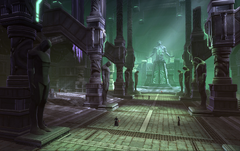
The Dark Temple's central chamber
Behind the large statue at the end of the hall, another staircase also connected the first and second floors, and a door on the upper levels of the staircase led to the Dark Temple's inner chambers. The eastern staircase to the mezzanine spiraled around a tree trunk-like sculpture that reached the Temple ceiling, and decorative tapestries that had been reduced to scraps by the time of the Cold War hung from the sides of the stairs as they did in the main hall. The mezzanine was lit by a number of green crystals that were suspended by chains from the ceiling, and like the first floor, the second floor featured four massive doorways on either sides of the hall. However, with the exclusion of the door to the eastern staircase and the door to a room known as the Unquiet Chamber, these portals were sealed off by either stonework or blast doors. The entire Dark Temple, especially the central hall, was filled a dim greenish light, and the floors were paved in gray stone with ornamental insets.[6] The overall architecture of the Dark Temple was specifically designed by the Emperor to contain dark side energy, allowing the Temple to serve as both a prison and a secure site for storing powerful artifacts.[2]
History[]
Early history and closure[]
- "Over a millennium past, the Emperor claimed Dromund Kaas and made the Dark Temple the epicenter of dark Force energy. In the bowels of the temple, he conducted horrifying experiments that drained the knowledge and life essence from all the greatest Sith Lords of the time."
- ―Darth Baras
The structure later known as the Dark Temple was originally built by the Sith Lord Pharshol and his servants, some of the original colonists on Dromund Kaas from the Old Sith Empire. Most of the colonists lived within the expansive building, as it was the only man-made structure on the hostile jungle planet, but Pharshol's rival Vacuus and the followers of the Sith philosophy known as the Dark Path infiltrated the structure and laid siege to Pharshol's servants. Pharshol, his apprentice Anyarah, and Vacuus were among those who died in the ensuing conflicts, and their spirits remained behind within the building as thousands of years passed.[1] When the Sith Lord Aloysius Kallig was betrayed by his fellow Sith Tulak Hord and killed in an ambush, Kallig was entombed in the structure's upper levels, though his spirit remained behind like that of Pharshol and Vacuus.[2] Around the time of Kallig's death, another Sith Lord named Ergast was buried in one of the adjacent mountains as well.[8]

The central statue in the Dark Temple
Dromund Kaas eventually became lost to the larger Empire, though it was rediscovered by the survivors of the Great Hyperspace War with the Republic in 4980 BBY, two decades after the Empire's defeat in the war. The survivors established a new empire under the rule of the Sith Emperor, and the Emperor was eventually drawn to the echoes of the dark side within the seemingly abandoned structure.[2] The Sith Lord Brontes's insights into the nature and purposes of Sith artifacts led the Emperor[9] to order a major expansion of the newly-named Dark Temple by the people of the Empire while they also worked on the construction of the nearby Kaas City,[7] and the Dark Temple was used by the Emperor over the following centuries to contain both the tombs of his enemies and artifacts that he created. The Emperor also utilized the Temple for many experiments and dark side rituals, transforming the structure and the surrounding area into a nexus of dark Force energy as he drained the knowledge and life essences of his most powerful enemies.[10]
The Sith Lord Nil Venerous was one of many who were entombed within the Dark Temple.[11] In 4606 BBY, the Sith Kel'eth Ur was killed by the Emperor on account of Ur's radical ideas that the Sith should embrace the light side of the Force, and Ur's body was buried in the Dark Temple's second level. While Ur's spirit did not endure like the others, as he became one with the Force, he managed to create a holocron containing his teachings and arranged for it to be placed on the door of his tomb.[12] Not long after that, the Emperor ordered the Dark Temple sealed, and the building lay undisturbed for almost a thousand years.[2]
Opening[]
- "With the Emperor's attention elsewhere, a group of ambitious, but ignorant, Sith thought to gain power by raiding the temple. They didn't find the relics they sought. Instead, they awoke an ancient Sith Lord—Lord Kallig—and their expedition plunged into madness."
- ―Alaric
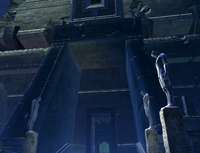
The Dark Temple's breached gates
Around 3643 BBY,[3] a group of ambitious Sith thought to take advantage of the Emperor's renewed absence during the Cold War, and they led an expedition of at least a hundred slaves, soldiers, and archaeologists that breached the Temple's gates. However, the Sith unknowingly awoke the spirit of Kallig, and the disoriented Force ghost lashed out in fury at the trespassers. The Empire's ruling Dark Council was unable to punish the rogue Sith because none of them returned alive from the expedition, and the Dark Temple was surrounded by violent electrical storms in the week following its opening.[5]
The Dark Council soon authorized Captain Fizik of the Imperial Military to dispatch additional expeditions into the Temple to determine the building's status after a flurry of seismic activity,[11] but because Kallig died in an ambush, his spirit was initially unaware of his own death, and he reached out with his power to unknowingly awaken the spirits of other Sith Lords in the Temple. Many of the workers, soldiers, and Sith from the expeditions were possessed by those Sith spirits, while others were driven insane by the dark side energy.[12] After the third expedition failed to return, Fizik secured the aid of additional Sith and Imperial forces to brave the Temple and retrieve the expedition's data. Fizik's team discovered that Dorian, one of the men from the expeditions, was recovering from the possession of Nil Venerous, and the group secured several of Venerous's symbols of power in exchange for the expedition data so that Dorian could remain in the Temple and rule over the possessed workers.[11] Over the next few months, the Dark Council ordered the Imperial Military to contain the threats within the Temple as the influence of the Sith spirits slowly spread outward down the Temple's processional approach, and the Sith Lord Alaric dispatched a team into the Temple in order to seal the burial chambers of those Sith Lords whose spirits were still dormant. When the team did not return, however, and Alaric was forced to recruit the aid of other Imperial-allied individuals to finish the job of fusing the 500-kilogram hinges on the tomb doors. The group succeeded in the mission, though they encountered Kel'eth Ur's holocron and destroyed it in order to prevent his teachings from spreading.[12]

One of the Dark Temple's hallways
The Sith Lord Darth Baras dispatched his apprentice to the Dark Temple in order to locate the Ravager, a device constructed by the Emperor that ripped knowledge from the minds of its victims, and the Sith Warrior was forced to battle workers possessed by the spirit of Lord Vacuus and his followers in order to retrieve the device and its missing components.[10] The Sith Lord Darth Zash sent her own apprentice into the Temple in order to fulfill the Force vision that she had of a slave-born apprentice pacifying the spirit of Lord Kallig. The apprentice, who was in fact Kallig's own descendant, was successful in contacting Kallig's spirit and also recovered an artifact of Tulak Hord in the process.[13]
Pharshol's spirit found a vessel in a Twi'lek workman, and he assumed power over his fellow workers as they were possessed by the shades of his past servants. However, the Human female who was possessed by his apprentice Anyarah tried to fight against the possession, causing Pharshol to believe she was being swayed by the Dark Path, and the Sith ordered her retrieval from the Temple's depths.[1] Commander Gargun led a team into the Dark Temple but failed to return, leaving his subordinate Captain Medle unable to prove his superior's death and thereby take his post. Medle therefore hired a bounty hunter during the galactic competition known as the Great Hunt to enter the Dark Temple and recover the commander's insignia, though the bounty hunter killed Medle when he turned on the mercenary in an attempt to cover up his actions.[14] The terrorist network under the leadership of the man known as the Eagle attempted to detonate the power conduits underneath the Dark Temple as part of a terrorist attack on Kaas City, though the attack was foiled by the Imperial Agent known as Cipher Nine, who killed the dissidents before they could detonate their bombs in the access tunnels.[7]
Darth Zash later summoned her apprentice to the Dark Temple after the Sith Inquisitor had recovered the rest of Tulak Hord's artifacts for her, and within the Dark Temple's inner chambers Zash attempted to use Hord's rituals to steal her apprentice's body. However, the resulting duel ended with Zash's spirit being shunted into the body of her apprentice's Dashade servant, Khem Val.[15] Not long afterwards, Zash's superior Darth Thanaton attempted to kill the young Inquisitor, who had taken on the title of Lord Kallig, by sending Kallig to the tomb of the Sith scholar and alchemist Darth Andru. After escaping Andru's spirit with the help of Aloysius Kallig, the young Sith journeyed to the Dark Temple and learned the ritual of Force walk, which allowed the Sith to bind the spirit of Ergast in order to gain more power. Kallig then departed the Dark Temple to bind Darth Andru as well, though the added power was not enough to overcome Thanaton when Kallig confronted the elder Sith.[8]
Confrontation[]
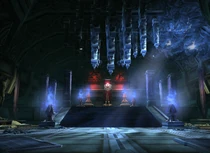
The Dark Temple's inner chambers
- "If I must die, everything dies with me."
"The temple is coming apart! We have to leave! Get back to your ship!" - ―The dying Emperor and Lord Scourge to the Hero
In 3640 BBY,[3] the Emperor himself returned to the Dark Temple with his Imperial Guard, and the Guard purged the Temple of all trespassers while the Emperor forced the Sith spirits back into submission. The Emperor remained in the Dark Temple's inner chambers and waited for the arrival of his enemy, the Jedi Knight known as the Hero of Tython, as the Jedi had managed to foil the Emperor's servants in their attempts to start the Sith ruler's life-consuming ritual. The Knight, having learned of the Emperor's location from the Jedi Master Tol Braga after the Emperor's hold over him was broken, infiltrated Kaas City and stole the Sith Emperor's shuttle while Grand Master Satele Shan of the Jedi Order led an attack on the Imperial capital, and the Hero's crew fought their way through the Imperial Guardsmen and Sith who defended the Dark Temple. After rescuing one of their companions from an overwhelming number of Imperial Guard in the access tunnels, the Hero and the astromech droid T7-O1 ascended the Dark Temple's staircase and made their way to the inner chambers, where the duo engaged the Sith Emperor in a final battle. Despite the Emperor's power, the duel ended with his defeat, and the Emperor's essence relinquished control of his dying host body before using the Force to bring down large sections of the Temple in order to kill the Hero. However, the Hero and T7-O1 were able to escape the collapsing Temple along with the rest of their companions, and the group escaped Dromund Kaas along with the rest of the Republic fleet.[4]
Behind the scenes[]
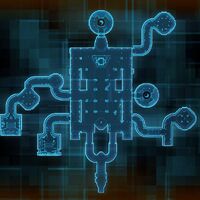
In-game map of the Dark Temple
The Dark Temple is a major set piece on the planet Dromund Kaas in Star Wars: The Old Republic, a video game released by BioWare and LucasArts in 2011. The in-game counterpart to the ruined Jedi Temple on the Republic capital of Coruscant, the Dark Temple is the site of the final Dromund Kaas missions for all four Imperial classes, and is also featured in a number of additional side missions.[6] The Dark Temple is revisited by the Sith Inquisitor class at the end of their Act I storyline,[15] and is the setting for the final confrontation with the Sith Emperor for the Jedi Knight class mission "Doomsday."[4] The Dark Temple was first pictured on the entry for Dromund Kaas in the Holonet section of the official site for Star Wars: The Old Republic,[16] and the 2012 reference guide Star Wars: The Old Republic Encyclopedia gave further information on the Temple.[2] The Dark Temple's name bears resemblance to the Dark Force Temple that appeared in the 1998 video game Star Wars: Jedi Knight: Mysteries of the Sith, though The Old Republic writer Hall Hood remained ambiguous on the subject when asked if the two were related.[17]
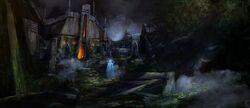
Concept art of the Dark Temple
Concept artist Diego Almazan was responsible for designing much of the Dark Temple, and a Studio Insider article was released on February 18, 2011 that discussed Almazan's process. Almazan began with the idea that the Sith structure was both an tomb and a prison for the dead, and the basic shapes of the building's hallways were intended to convey power and resilience. He then added organic patterns of sculpture to the walls in a fashion that was meant to remind players of incantations and runes, and Almazan then proceeded to apply chips, cracks, and discoloration to the surfaces while also adding patterns to the floors and roofs. The pillars that line the Dark Temple's hallways were added to give the building an aggressive feel, as well as create the idea that they were locks for the Sith tombs within. Almazan's final concepts for the design added mood lighting, and the artist decided to add greenish lamps to break up the darkness while also inserting a number of webs that gave the impression of age.[18]
The Bounty Hunter, Imperial Agent, Sith Warrior, and Sith Inquisitor are all Imperial characters, and therefore they are assumed to only choose the dark side alignment options.[19] As a result, this article assumes that both the class missions and the optional side missions were completed using the dark side options, and also refrains from specifying what character completed the side missions. Conversely, as the Jedi Knight is a Republic character and therefore is assumed to only choose the light side options,[20] this article assumes that the player did redeem Tol Braga and also rescued their companion from the Imperial Guard before facing the Emperor.[4]
Cut content[]
Several Codex entries and a Heroic Mission located within the Dark Temple were initially present in The Old Republic during the game's beta release, but they were removed for unknown reasons, and are therefore considered cut content.
After creating the Phobis devices, powerful artifacts that allowed their users to manipulate fear on an immense scale, the Emperor locked away the Phobis Core in the depths of the Dark Temple.[21] The Sith Executioner Koval Renge, the Emperor's personal enforcer, was cast into the Dark Temple by the Emperor after Renge's attempt to betray his master ended in failure.[22]
Around 3683 BBY, the Sith Lord Parnax deliberately invaded the Dark Temple, breaking the seal only to find himself unable to leave the Dark Temple once inside. Becoming lost and disoriented, Parnax descended into madness, with his journals recording that he somehow discovered the Emperor's plans to consume all life in the galaxy, though no one understood his incoherent writings when they were discovered. In his insanity, Parnax committed suicide in the belief that he could survive the galaxy's end by merging with the Force itself, and the Dark Temple was sealed once more not long afterwards.[23]
The Mandalorian bounty hunter Valen Korik betrayed the Imperial-Mandalorian alliance when he killed two Sith Lords in open combat in Kaas City, and Korik fled to the Dark Temple when the Dark Council issued a bounty on his head. Korik quickly became possessed by the spirits within the Temple, and he inhabited the building's western reliquary until an Imperial team braved the Temple and killed him.[24]
Appearances[]
- Star Wars: The Old Republic (First appearance)
- Star Wars: The Old Republic: Rise of the Hutt Cartel
Sources[]
 Dromund Kaas on The Old Republic Holonet (backup link) (content now obsolete; original version) (First pictured)
Dromund Kaas on The Old Republic Holonet (backup link) (content now obsolete; original version) (First pictured) Concept Art – Sith Temple on The Old Republic's official website (backup link)
Concept Art – Sith Temple on The Old Republic's official website (backup link) Studio Insider – Sith Temple on The Old Republic's official website (backup link)
Studio Insider – Sith Temple on The Old Republic's official website (backup link)- Star Wars: The Old Republic Explorer's Guide
- Star Wars: The Old Republic Encyclopedia
 Star Wars: The Card Game — Knowledge and Defense (Card: Dark Temple) (Picture only)
Star Wars: The Card Game — Knowledge and Defense (Card: Dark Temple) (Picture only)
Notes and references[]
- ↑ 1.0 1.1 1.2 1.3 1.4
 Star Wars: The Old Republic — Imperial Mission: "Secret Kinds of Darkness" on Dromund Kaas
Star Wars: The Old Republic — Imperial Mission: "Secret Kinds of Darkness" on Dromund Kaas
- ↑ 2.0 2.1 2.2 2.3 2.4 2.5 2.6 Star Wars: The Old Republic Encyclopedia
- ↑ 3.0 3.1 3.2
 Forums: Dear Story Team, What Year Are We Currently In? on The Old Republic's official website (backup link) and Star Wars: The Old Republic Encyclopedia date the finales of Star Wars: The Old Republic's class storylines in 3640 BBY, and place the subsequent Battle of Ilum at the end of that same year.
Forums: Dear Story Team, What Year Are We Currently In? on The Old Republic's official website (backup link) and Star Wars: The Old Republic Encyclopedia date the finales of Star Wars: The Old Republic's class storylines in 3640 BBY, and place the subsequent Battle of Ilum at the end of that same year.
- ↑ 4.0 4.1 4.2 4.3
 Star Wars: The Old Republic — Jedi Knight Mission: "Doomsday" on Dromund Kaas
Star Wars: The Old Republic — Jedi Knight Mission: "Doomsday" on Dromund Kaas
- ↑ 5.0 5.1 5.2 5.3
 Star Wars: The Old Republic — Codex: "Dark Temple"
Star Wars: The Old Republic — Codex: "Dark Temple"
- ↑ 6.0 6.1 6.2 6.3 6.4 6.5 6.6 6.7 6.8 6.9 Star Wars: The Old Republic
- ↑ 7.0 7.1 7.2
 Star Wars: The Old Republic — Imperial Agent Mission: "Doom and the Dark Temple" on Dromund Kaas
Star Wars: The Old Republic — Imperial Agent Mission: "Doom and the Dark Temple" on Dromund Kaas
- ↑ 8.0 8.1
 Star Wars: The Old Republic — Sith Inquisitor Mission: "Sith Hierarchy" on Dromund Kaas
Star Wars: The Old Republic — Sith Inquisitor Mission: "Sith Hierarchy" on Dromund Kaas
- ↑
 Star Wars: The Old Republic — Codex: "Dread Master Brontes"
Star Wars: The Old Republic — Codex: "Dread Master Brontes"
- ↑ 10.0 10.1
 Star Wars: The Old Republic — Sith Warrior Mission: "An Ancient Answer" on Dromund Kaas
Star Wars: The Old Republic — Sith Warrior Mission: "An Ancient Answer" on Dromund Kaas
- ↑ 11.0 11.1 11.2
 Star Wars: The Old Republic — Mission: "The Wretch King" on Dromund Kaas
Star Wars: The Old Republic — Mission: "The Wretch King" on Dromund Kaas
- ↑ 12.0 12.1 12.2
 Star Wars: The Old Republic — Mission: "Buried Power" on Dromund Kaas
Star Wars: The Old Republic — Mission: "Buried Power" on Dromund Kaas
- ↑
 Star Wars: The Old Republic — Sith Inquisitor Mission: "In the Halls of Traitors" on Dromund Kaas
Star Wars: The Old Republic — Sith Inquisitor Mission: "In the Halls of Traitors" on Dromund Kaas
- ↑
 Star Wars: The Old Republic — Bounty Hunter Mission: "The Spy Game" on Dromund Kaas
Star Wars: The Old Republic — Bounty Hunter Mission: "The Spy Game" on Dromund Kaas
- ↑ 15.0 15.1
 Star Wars: The Old Republic — Sith Inquisitor Mission: "Legacy" on Dromund Kaas
Star Wars: The Old Republic — Sith Inquisitor Mission: "Legacy" on Dromund Kaas
- ↑
 Dromund Kaas on The Old Republic Holonet (backup link) (content now obsolete; original version)
Dromund Kaas on The Old Republic Holonet (backup link) (content now obsolete; original version)
- ↑
Hall Hood (@hallhood) on Twitter (backup link)
- ↑
 Studio Insider – Sith Temple on The Old Republic's official website (backup link)
Studio Insider – Sith Temple on The Old Republic's official website (backup link)
- ↑ It is assumed that the Sith Empire classes in Star Wars: The Old Republic choose the options that provide the most dark side alignment points.
- ↑ It is assumed that the Republic classes in Star Wars: The Old Republic choose the options that provide the most light side alignment points.
- ↑
 Star Wars: The Old Republic — Codex: "The Phobis Devices"
Star Wars: The Old Republic — Codex: "The Phobis Devices"
- ↑
 Star Wars: The Old Republic — Codex: "Blade of the Sith Executioner"
Star Wars: The Old Republic — Codex: "Blade of the Sith Executioner"
- ↑
 Star Wars: The Old Republic — Codex: "Lord Parnax's Lost Recordings"
Star Wars: The Old Republic — Codex: "Lord Parnax's Lost Recordings"
- ↑
 Star Wars: The Old Republic — Mission: [Heroic] "Possessed Hunter" on Dromund Kaas
Star Wars: The Old Republic — Mission: [Heroic] "Possessed Hunter" on Dromund Kaas
External links[]
 The Dark Temple on Star Wars: The Old Republic Wiki
The Dark Temple on Star Wars: The Old Republic WikiStar Wars The Old Republic on Jarrod Hollar's profile on ArtStation (backup link)
